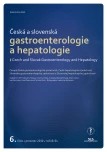Extraesophageal reflux up-to-date
Authors:
Karol Zeleník 1; P. Schwarz 1; O. Urban 2,3; J. Vydrová 4; Pavel Komínek 1
Authors‘ workplace:
Otorinolaryngologická klinika FN Ostrava, 2Interní klinika FN Ostrava, 3Centrum péče o zažívací trakt, Vítkovická nemocnice a. s., Ostrava, 4Hlasové centrum Praha
1
Published in:
Gastroent Hepatol 2010; 64(6): 10-14
Category:
Review Article
Overview
Extraesophageal symptoms of gastroesophageal reflux disease (posterior laryngitis, vocal fold granuloma, globus pharyngeus, subglotis and tracheal stenosis, laryngopharyngeal carcinoma, poorly controlled asthma bronchiale, paroxysmal cough and others) have been studied more since the 1990‘s. It was long believed that extraesophageal reflux causes mucosal damage of the hypopharynx and larynx in the same way as gastroesophageal reflux in the oesophagus. However, this premise did not work in practice (only a few extraesophageal reflux episodes have been proven during pH-metry, poor correlation between symptoms and findings, limited effect of proton pump inhibitors) and this led to scepticism regarding the role of extraesophageal reflux in the pathogenesis of the diseases mentioned above. But research in the last few years has revealed much new information about the pathogenesis of extraesophageal reflux and has completely changed our understanding of this controversial issue. Acidity alone is no longer considered to be the main pathogenetic agent during extraesophageal reflux episodes, while pepsin, which maintains its stability and activity also in weakly acid refluxes, is considered to play an essential role. Furthermore, it has been revealed that mucosa of the hypopharynx, larynx and other parts of the airways is much more sensitive to refluxate than esophageal mucosa. Therefore, treatment is focused not only on cutting down the acidity, but also on reducing reflux episodes and minimizing the negative pepsin effect.
Key words:
extraesophageal reflux – esophageal impedance – weakly acid reflux – oropharyngeal pH-monitoring – pepsin
Sources
1. Zeleník K, Komínek P, Stárek I et al. Extraezofageální reflux (1. část). Epidemiologie, patofyziologie a diagnostika. Otorinolaryngologie a Foniatrie 2008; 57: 143–150.
2. Lukáš K et al. Refluxní choroba jícnu. Praha: Nakladatelství Karolinum 2003.
3. Lukáš K, Bureš J, Drahoňovský V et al. Refluxní choroba jícnu. Standardy České gastroenterologické společnosti – aktualizace 2009. Čes a Slov Gastroent a Hepatol 2009; 63: 76–85.
4. Johnston N, Wells CW, Samuels TL et al. Pepsin in nonacidic refluxate can damage hypopharyngeal epithelial cells. Ann Otol Rhinol Laryngol 2009; 118(9): 677–685.
5. Johnston N, Dettmar PW, Bishwokarma B et al. Activity/stability of human pepsin: implications for reflux attributed laryngeal disease. Laryngoscope 2007; 117(6): 1036–1039.
6. Johnson N, Knight J, Dettmar PW et al. Pepsin and carbonic anhydrase isoenzyme III as diagnostic markers for laryngopharyngeal reflux disease. Laryngoscope 2004; 114(12): 2129–2134.
7. Johnston N, Dettmar PW, Lively MO et al. Effect of pepsin on laryngeal stress protein (Sep70, Sep53, and Hsp70) response: role in laryngopharyngeal reflux disease. Ann Otol Rhinol Laryngol 2006; 115(1): 47–58.
8. Samuels TL, Johnston N. Pepsin as a causal agent of inflamation during nonacidic reflux. Otolaryngol Head Neck Surg 2009; 141(5): 559–563.
9. Weiner GJ, Tsukashima R, Kelly C et al. Oropharyngeal pH monitoring for the detection of liquid and aerosolised supraesophageal gastric reflux. J Voice 2009; 23(4): 498–504.
10. Ayazi S, Lipham JC, Hagen JA et al. A new technique for measurement of pharyngeal pH: normal values and discriminating pH threshold. J Gastrointest Surg 2009; 13(8): 1422–1429.
11. Cook IJ. Clinical disorders of the upper esophageal sphincter. GI Motility online [online]. c2006, [cit. 2010-04-30]. Dostupné z <http://www.nature.com/gimo/contents/pt1/full/gimo37.html> .
12. Koufman JA. Laryngopharyngeal reflux is different from classic gastroesophageal reflux disease. Ear, Nose Throat J 2002; 81 (9 Suppl 2): 7–9.
13. Johnston N, Dettmar PW, Bishwokarma B et al. Activity/stability of human pepsin: implications for reflux attributed laryngeal disease. Laryngoscope 2007; 117(6): 1036–1039.
14. Bardhan KD. Reflux re-visited! Reflexctions and re-direction. Abstract book. Reflux and its consequences. Key opinions in laryngeal, pulmonary and oesophageal manifestations, Hull, United Kingdom, 21.–23. 4. 2010: 36.
15. Dolina J, Kala Z, Prokešová J et al. Nové možnosti v diagnostice refluxní nemoci jícnu. Čes a Slov Gastroent a Hepatol 2009; 63: 186–190.
16. Conchillo JM, Smout AJ. Review article: intra-oesophageal impedance monitoring for the assessment of bolus transit and gastro-oesophageal reflux. Aliment Pharmacol Ther 2008; 29: 3–14.
17. Strugala V, Dettmar PW, Morice AH. Detection of the pepsin in sputum and exhaled breath condensate: could it be a useful marker for reflux-related respiratory disease? Gastroenterology 2009; 136 (5 Suppl 1): S1895.
18. Strugala V, Avis J, Jolliffe IG et al. The role af an alginate suspension on pepsin and bile acids – key aggressors in the gastric refluxate. Does this have implications for the treatment of gastro-oesophageal reflux disease? Journal of Pharmacy and Pharmacology 2009; 61: 1021–1028.
19. McGlashan JA, Johnstone LM, Sykes J et al. the value of liquid alginate suspension (Gaviscon Advance) in the management of laryngopharyngeal reflux. Eur Arch Otorhinolaryngol 2009; 266(2): 243–251.
20. Drahoňovský V, Vrbenský L, Kmeť L et al. Laparoskopická antirefluxní operace u 100 operovaných po 2 a 5 letech ve srovnání s předoperačním stavem. Čes a Slov Gastroent a Hepatol 2006; 60: 17–25.
Labels
Paediatric gastroenterology Gastroenterology and hepatology SurgeryArticle was published in
Gastroenterology and Hepatology

2010 Issue 6
Most read in this issue
- Extraesophageal reflux up-to-date
- Biodegradable stents in benign stenosis of the biliary tract
- Non-steroidal anti-inflammatory drugs induced colopathy, mimicking Crohn’s disease
- Fertility, pregnancy, breastfeeding and chronic inflammatory bowel diseases – Consensus of the ECCO 2010
